Sometime about five years from now, this will be a subway station. Today, the tunnel boring machine that will complete nearly mile-long long tunnels between Capitol Hill and downtown as part of the U-Link light rail project is powered up and waiting in the construction pit at Broadway and Denny. In a few weeks, its journey will begin. Crews will slowly ramp up and, in about a month, the 24-hour work and trucking at the site will kick in as the machine digs its way to downtown, spitting out a constant flow of spoils along the conveyor system behind it.
Working up to 150 feet below your feet, Sound Transit engineers say it is unlikely you will ever see or hear the machine on its path — and, they say, lessons learned in the Beacon Hill tunneling should prevent a re-occurrence of the “sandy voids” that opened up during that construction process and caused people in that neighborhood a little worry about what lurked below.
Where the tunneling from the University of Washington’s Husky Stadium to Broadway started with dignitaries and champagne, the start of boring from Capitol Hill to downtown will begin with tours. Saturday, Sound Transit is hosting an event in the northwest corner of Cal Anderson park to mark the start of 18 months of tunneling between Broadway and downtown. With the UW machinery already on its way, the real tunneling from the Hill to Pine won’t begin for a few weeks. But when it does, it will mark the transition of the once-in-a-generation project to a 24-hour-a-day race against time and the pressure of 150 feet of soil and ground water.
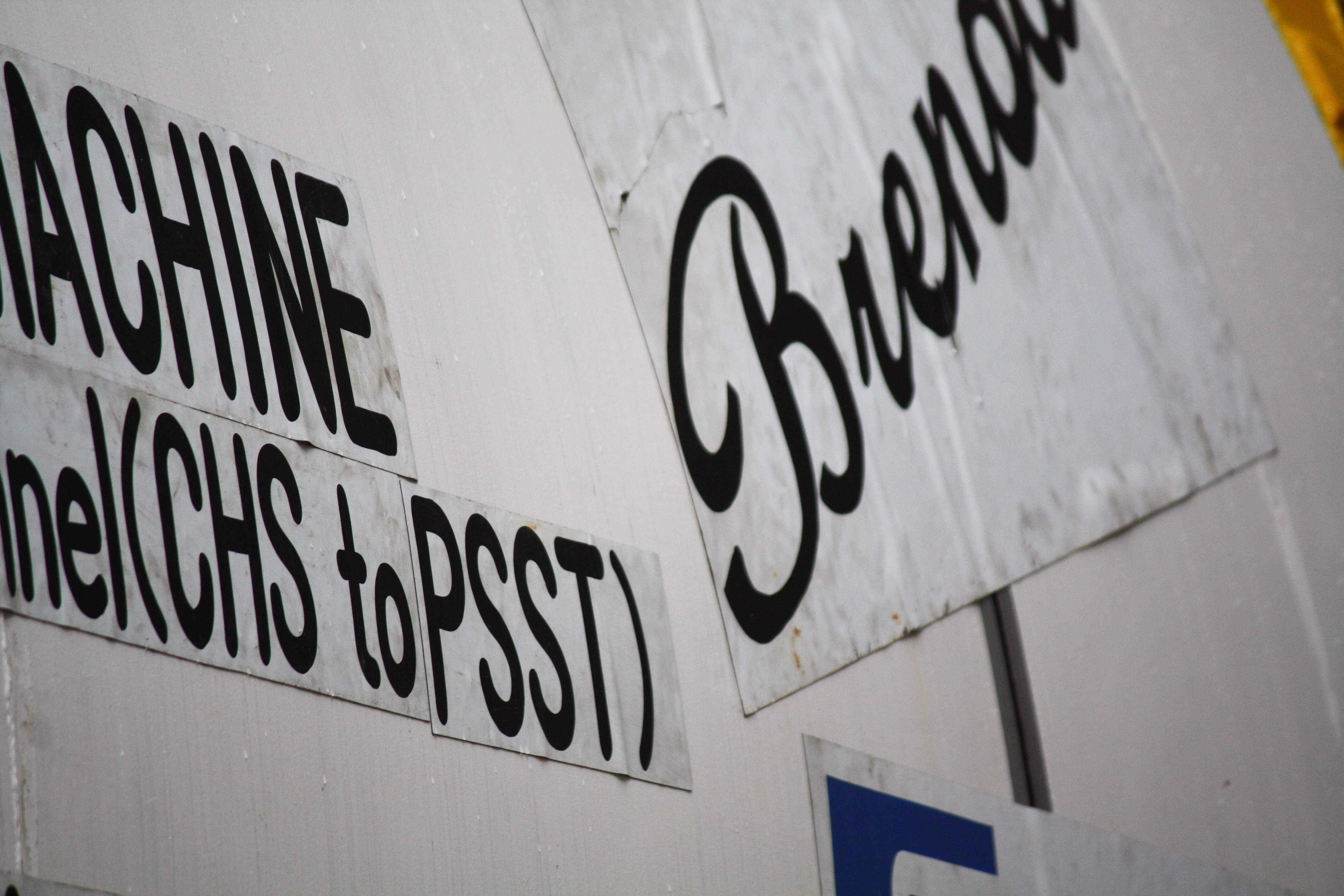 Capitol Hill’s tunnel boring machine — nicknamed Brenda — is the key component for the next phase of constructing the $1.9 billion U-Link light rail line between downtown Seattle and the University of Washington via Broadway. Unlike the UW end of things where two machines will do the job, Brenda works alone. The machine will set off after a few more weeks of testing on a 7/10ths of a mile journey to the extraction shaft on Pine near the Paramount. There, sometime near the end of 2011, she’ll bust through the concrete wall of the shaft, be taken apart and brought to the surface, and then trucked back to Broadway where her journey will begin again on the companion tunnel to downtown.
Capitol Hill’s tunnel boring machine — nicknamed Brenda — is the key component for the next phase of constructing the $1.9 billion U-Link light rail line between downtown Seattle and the University of Washington via Broadway. Unlike the UW end of things where two machines will do the job, Brenda works alone. The machine will set off after a few more weeks of testing on a 7/10ths of a mile journey to the extraction shaft on Pine near the Paramount. There, sometime near the end of 2011, she’ll bust through the concrete wall of the shaft, be taken apart and brought to the surface, and then trucked back to Broadway where her journey will begin again on the companion tunnel to downtown.
At 30-foot long and with about 330 feet of trailing gear, Brenda is a large creature. She is named, by the way, for a project manager’s wife. In honor of the woman, we’re certain. According to Sound Transit, the machine will be launched from the Capitol Hill site sometime late this month and will bore the first tunnel between Broadway and the removal shaft constructed off Pine near the Paramount Theater (where these cool old Seattle artifacts were unearthed).
Between Husky Stadium and downtown, the twin tunnels will be dug beneath about 250 homes and several municipal structures at depths between 15 feet (beneath the Montlake cut) and 300 feet (beneath Volunteer Park) below the surface. The deepest digging past Broadway will bottom out at a still impressive 150 feet below the pavement.
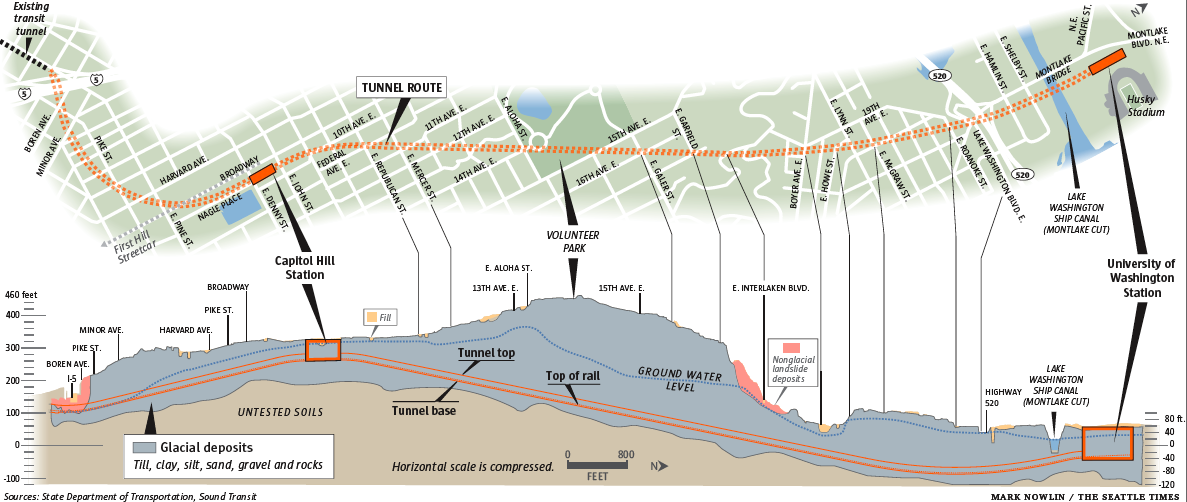 Full PDF Version (Seattle Times)
Full PDF Version (Seattle Times)
Ten workers on 10-hour shifts will be along for the ride. They include six people to operate the tunnel boring machine and monitor systems, three to ride behind in a trailing gantry to install the large cement rings that will form the tunnel and one locomotive engineer. The one person who died in the Beacon Hill tunneling was a mechanic who fell from the trailing locomotive.
Much of the crew’s attention will be on maintaining proper “earth pressure balance.” From a recent presentation to the the Sound Transit board, engineers investigating Beacon Hill’s sandy void collapses said improper balance caused huge displacements of soil that created the void situations near homes above. Here are the slides from the session.
Beacon Hill Voids Update_compressed
Sound Transit spokesperson Bruce Gray's explained to CHS last year how the Capitol Hill tunneling work will better handle sandy voids:
We have different contractors doing the tunneling and using lessons learned from Beacon Hill, we’ll have a more exhaustive monitoring program of all tunneling activities. In a nutshell, the contractor took out too much material while boring a small section of the Beacon Hill tunnels.
During tunneling you can estimate how much material you need to excavate per foot or so. If you see more material coming out, it tells you there may be something flowing into the path of the TBM from above – sand, water, loose soils – and you make adjustments to keep those materials out. At its most basic level, you make adjustments to the pressure your machine is exerting from its face and sides. This pressure can come from a clay-like mixture being pushed out of the sides or face of the machine.
One new measure we’ll be using to monitor the ground and excavation conditions during U-Link tunneling will be constant measurements of the ambient earth pressure on the head of the TBM. Being able to see this in real time will give us a better picture of how much pressure should be on the cutter head as it’s excavating. Maintaining the proper “earth pressure balance” ensures you are removing the appropriate volume of materials. Essentially, you want maintain enough pressure on the head of the machine to keep materials from the sides of your tunnel from being excavated. Knowing the ambient pressure will tell us if the contractor is maintaining the proper pressure from the TBM side.
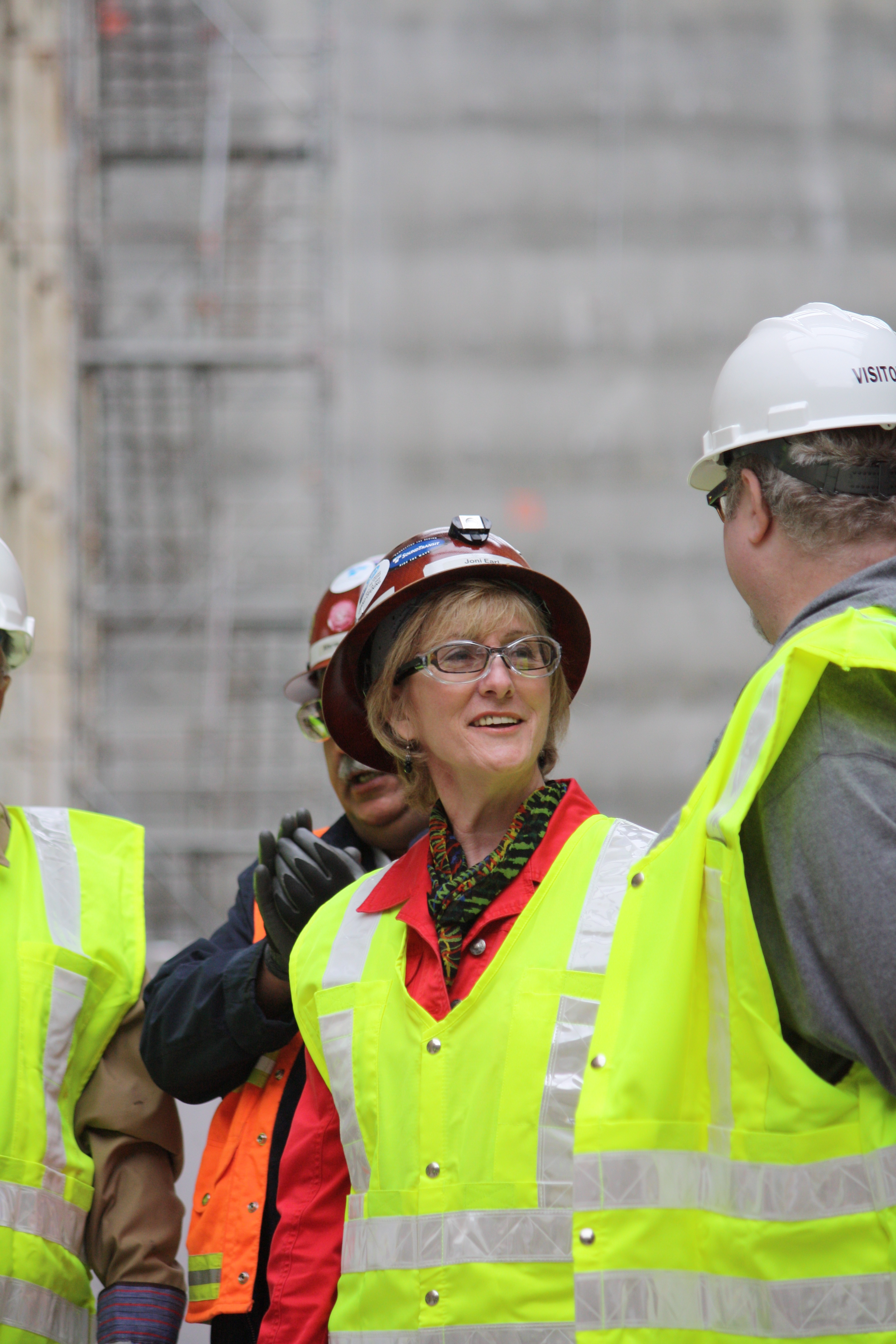 Sound Transit CEO Joni Earl talking with Capitol Hill Chamber director Michael Wells
Sound Transit CEO Joni Earl talking with Capitol Hill Chamber director Michael Wells
Sound Transit has said that the voids created Beacon Hill were the result of the displacement of pockets of sandy soil by the tunnel boring process. Sound Transit documents detailing the geology and soils of the planned University Link tunnels say the same type of structures exist deep underneath Capitol Hill.
Glacial lacustrine deposits were encountered beneath the outwash deposits to the depth of the borings (130 to 160 feet). For alternatives to Capitol Hill, greater thicknesses of pre-Vashon non-glacial fluvial deposits were observed in borings drilled by the PSTC Design Team (2005), which appear to thicken from upwards of 60 to 80 feet of granular soils near the Montlake Cut to more than 130 feet near E Roy Street.
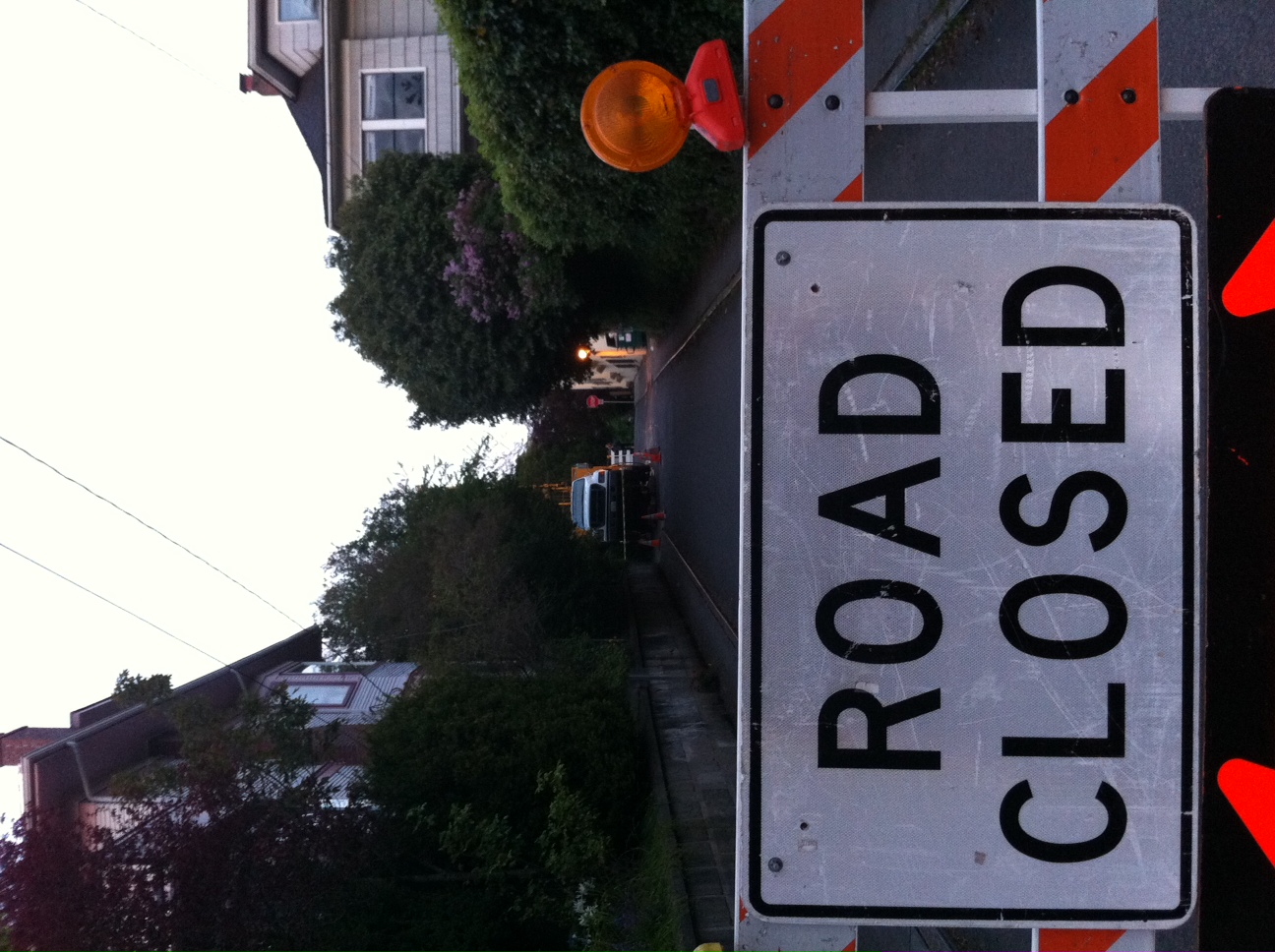 One of hundreds of monitors being installed (Image: Tipster Roger)
One of hundreds of monitors being installed (Image: Tipster Roger)
Sound Transit dug dozens of test bores across the Hill, some down to about 400 feet near the water tower at Volunteer Park. The results confirmed the comparable geology -- layers of clay and sand throughout most of the Hill.
To make sure their precautions and safeguards are working, Sound Transit has also placed ground motion monitoring along the entirety of the U-Link alignment sometimes as tightly clustered as a monitor every two blocks. If you've seen trucks on side streets -- or even in Volunteer Park -- lately drilling holes, there's a good chance crews are installing the monitoring equipment. Additionally, Sound Transit has photographic and video records of the conditions beneath many of the houses and buildings directly in the path of the tunneling. Should any issues come up, new imagery can be produced and compared to the original pictures and video to better assess the situation. Sound Transit has also agreed on around 200 easement contracts along this line of light rail.
Back at Denny and Broadway, the round-the-clock work will continue for about 18 months. Some 100,000 cubic yards of dirt have already been removed from the site. An equal amount will be trucked away over the next year and a half. The project was approved for a noise variance last spring to allow 24-hour work because not allowing the schedule "would cause unsafe working conditions, would increase the risk of voids in the soil and subsidence of the surface above the tunnel, and would produce a hardship to the public because it would take longer and add more cost to complete the project," the DPD wrote in its decision granting the variance.
If you have any issues during the construction, you can call the Sound Transit hotline at (888) 298-2395.
Our journey out of the construction site in the "man basket" during Friday's media tour of the site.



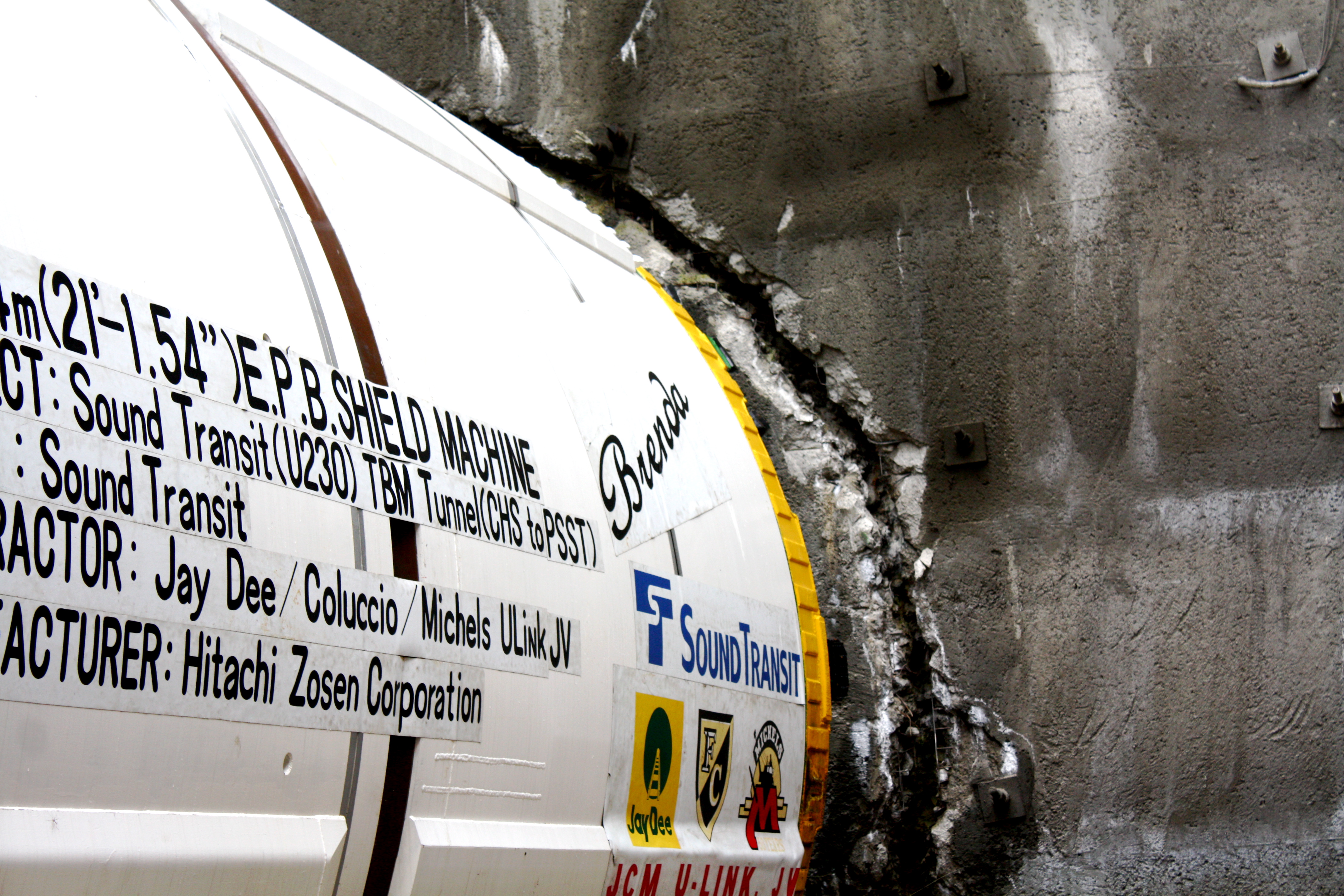
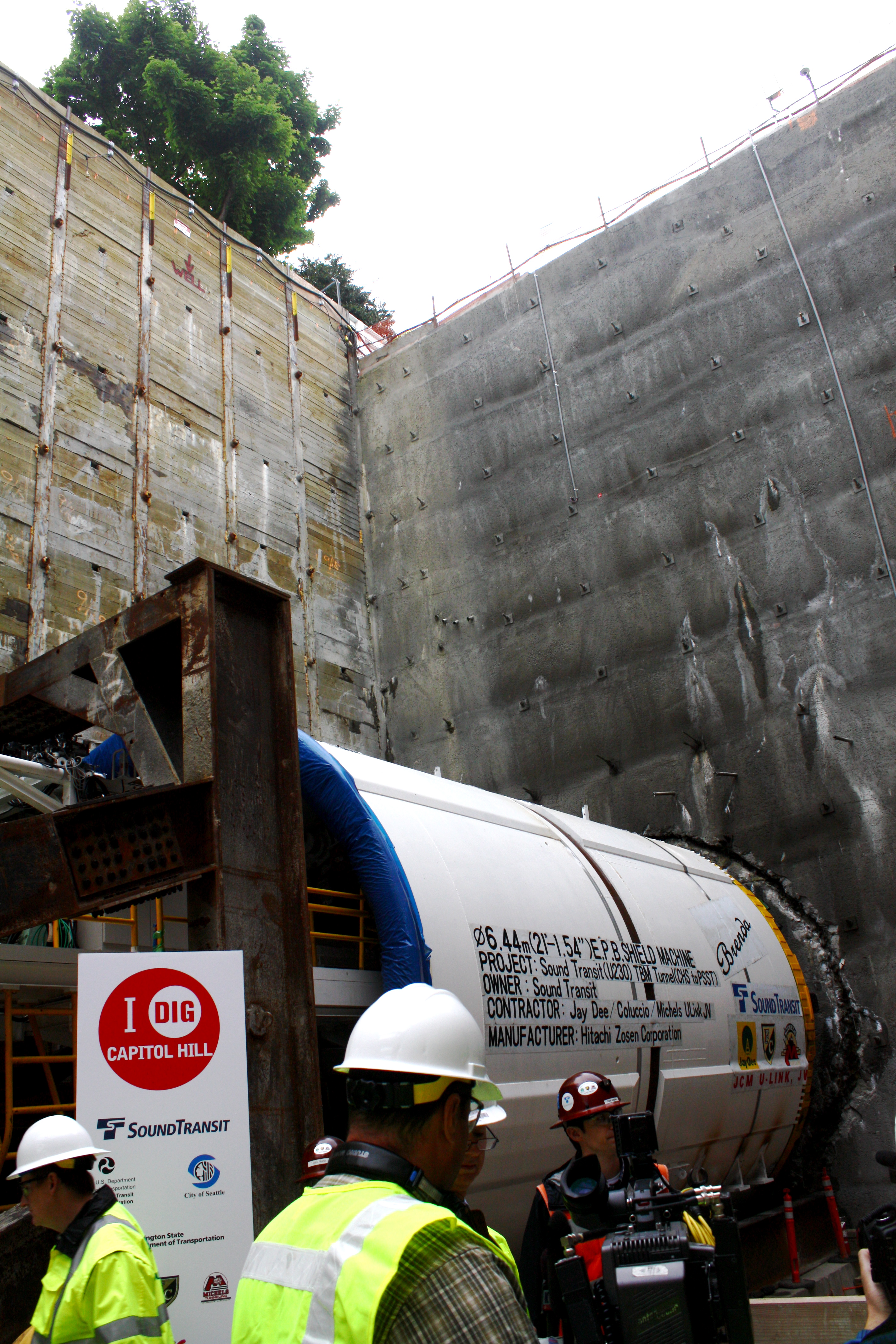
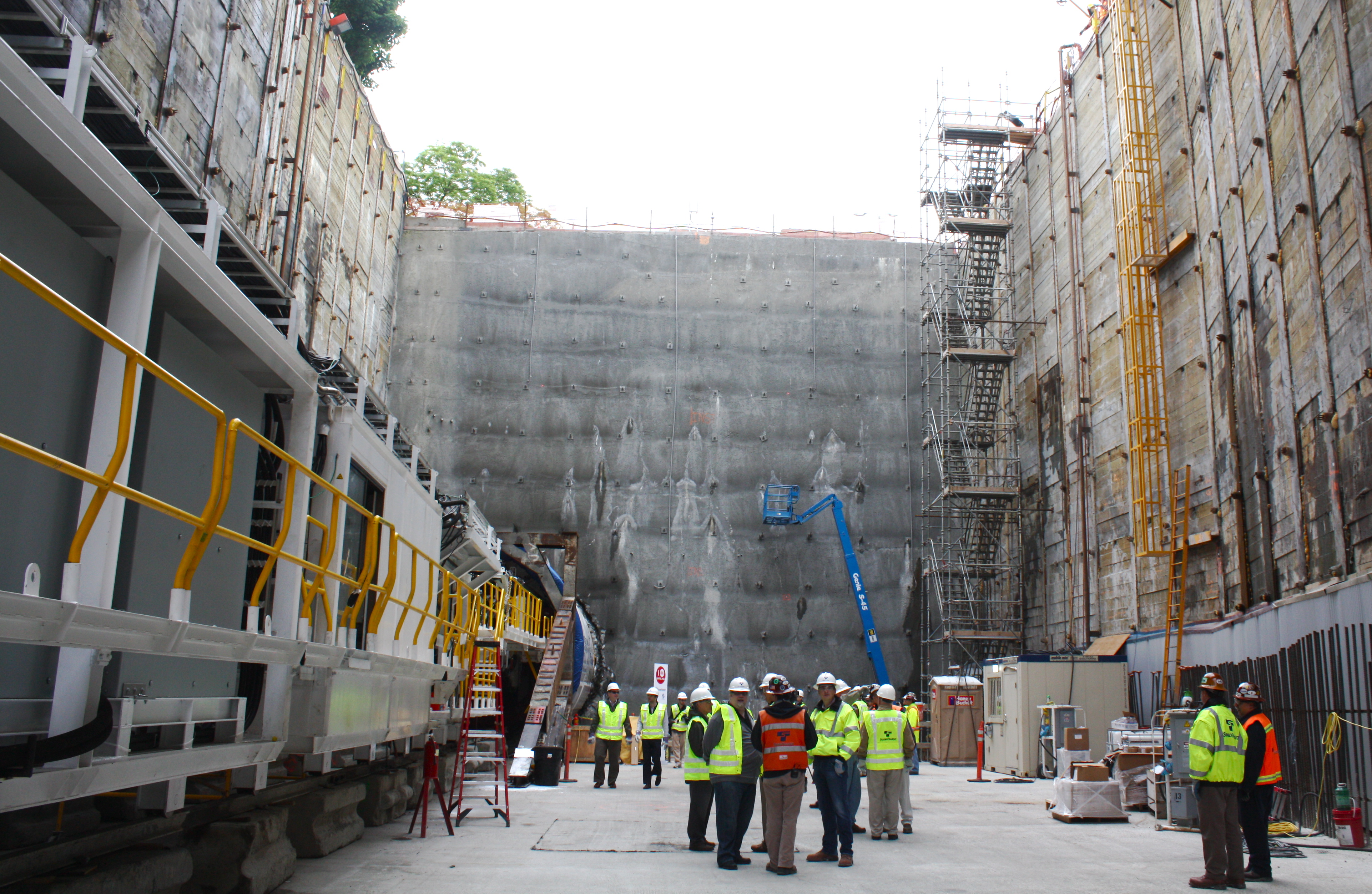
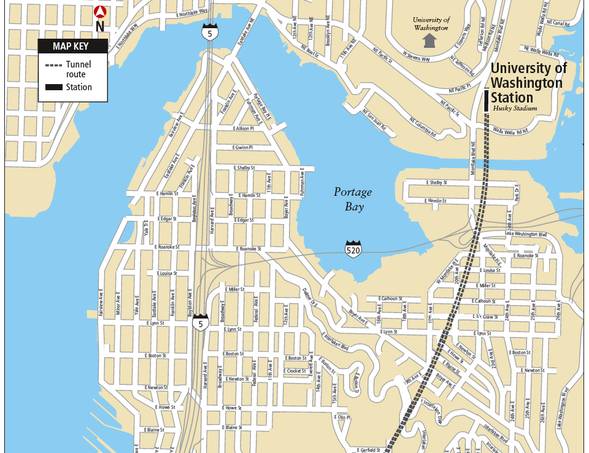
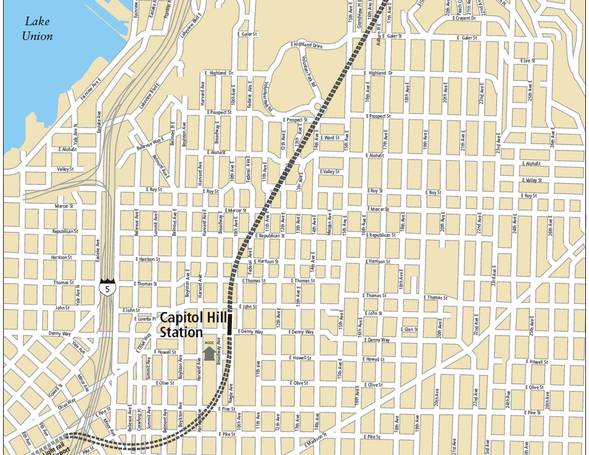
I can’t be the only one worried about the noxious gas leaking out of the ground after this machine tears its way into the heart of the city, making the dead reach up and pursue us, can I? >.>
(reference: http://amzn.to/mytHos)
It’s leaking SOCIALISM.
Brenda is Eco-friendly electric powered destruction machine. I am assuming any zombies disturbed will be vegan.
Am I the only one surprised that the ground water level is higher or lower in different parts of town? Does it have to do the the density of soil in some areas? I guess I’ve just never thought about how that works, and assumed it’d be sea level everywhere…
UV,
In many areas, shallow groundwater such as illustrated on the Seattle Times image is “perched,” sitting in more permeable or porous soils (sand/gravel) atop lenses or layers of less permeable material (silt/clay). It is a fairly dynamic environment, but in general the shallow groundwater comes from infiltration of rain water. While it can be an indicator, the water table elevation doesn’t always relate to “sea level” or the elevation of other surface water bodies.
Awesome. Thanks, Derek.
It’s about time we upgraded our transportation system.
This is exciting
Its mouth was some 80 meters in diameter … crystal teeth with the curved shape of crysknives glinting around the rim … the bellows breath of cinnamon, subtle aldehydes … acids …